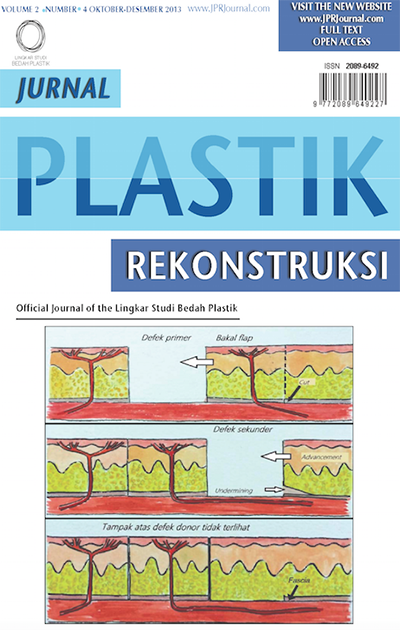Factors Associated with Occurrence of Amputation in Electrical Burns
DOI:
https://doi.org/10.14228/jpr.v2i4.177Abstract
Background: Electrical burns can cause damage to blood vessels in the burning extremities . This damage can lead to amputation that significantly impacts both physically and psychologically that affects the quality of life. This study aimed to determine the incidence and factors associated with the occurrence of amputation in electrical burns.
Method: A retrospective cohort study was done to patients with electrical burns that came to RSHS from 2011 to 2013. Mulativariate analysis, logistic regression, was performed on the factors associated with the occurrence of amputation in electrical burns.
Result: Most of the electrical burns were suffered by men (93.5%) at reproductive age (mean 34.1 years; range 10-60 years of age). The incidence of amputation in electrical burns is 54.8% from 31 patients. There is a significant relationship between the causes of high-voltage electrical burns> 1000V with the occurrence of amputation (p = 0.008; Relative risk ratio 8,125 ; 95% CI= 1,62-40,752) and there is a significant relationship between the presence of third degree of burns with amputation (p = 0,011; Relative risk ratio 16; 95 % CI=1,643-155,76). There is no significant relationship between the extent of burns and lactate levels with the amputation on electrical burns.
Conclusion: Amputation in electrical burns have a fairly high incidence. High electrical voltage> 1000V and presence of third degree of burns are associated with the occurrence of amputation.

Downloads
Published
Issue
Section
License

This work is licensed under a Creative Commons Attribution-NonCommercial-NoDerivatives 4.0 International License.
Authors retain the copyright of the article and grant Jurnal Plastik Rekonstruksi the right of first publication with the work simultaneously licensed under a Creative Commons Attribution License. Articles opting for open access will be immediately available and permanently free for everyone to read, download and share from the time of publication. All open access articles are published under the terms of the Creative Commons Attribution-Non-commercial-NoDerivatives (CC BY-NC-ND) which allows readers to disseminate and reuse the article, as well as share and reuse of the scientific material. It does not permit commercial exploitation or the creation of derivative works without specific permission.













